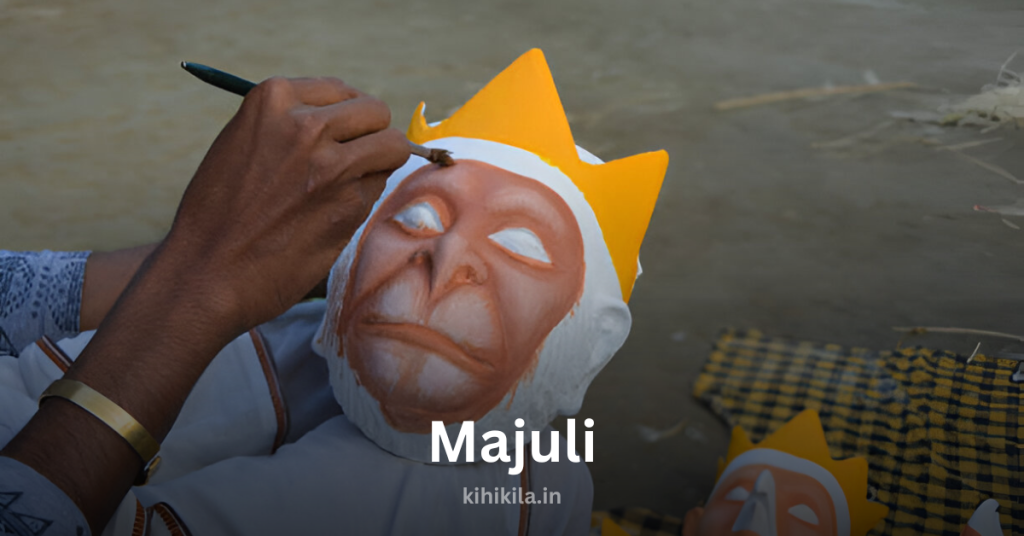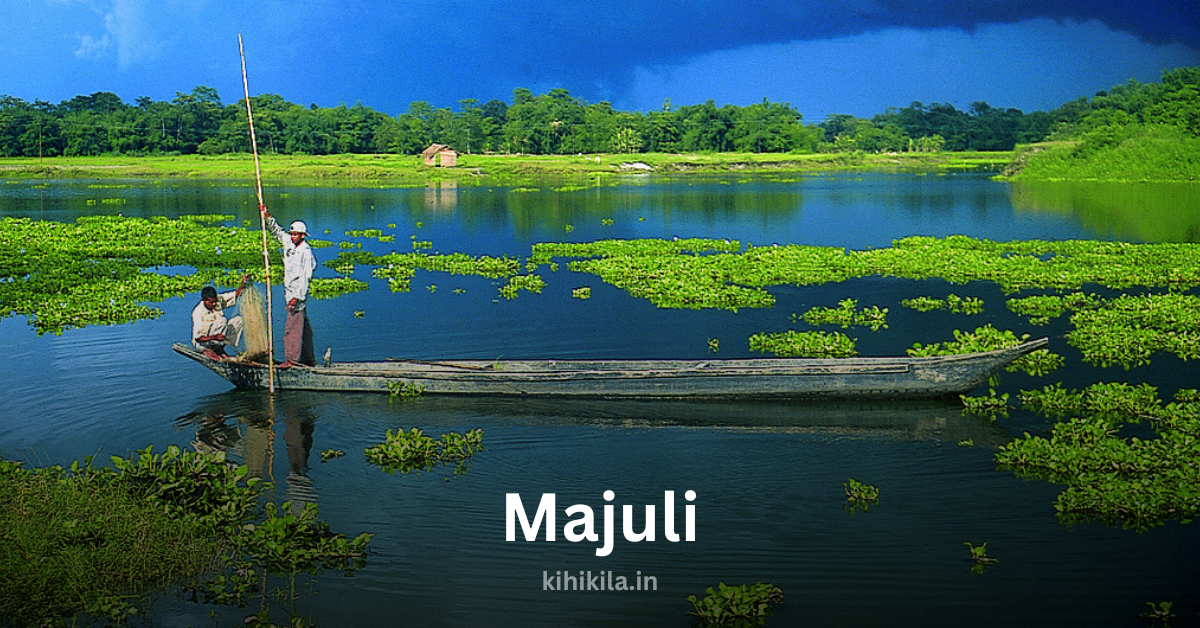Introduction
Majuli, located in the mighty Brahmaputra River in Assam, holds the distinction of being India’s largest river island. It is not just a geographical marvel but a cultural and spiritual hub that has played a significant role in preserving Assamese heritage. With its serene landscapes, unique Vaishnavite monasteries, and rich agricultural traditions, Majuli is an extraordinary place that continues to capture the attention of historians, nature lovers, and cultural enthusiasts alike.

The Formation and Geographical Significance of Majuli
Majuli’s existence is a result of the ever-changing course of the Brahmaputra River and its tributaries. Historically, it was a narrow stretch of land formed between two rivers. However, a massive flood in 1750 reshaped the region, leading to the formation of what we now know as Majuli. Over the years, continuous erosion has significantly reduced its size, yet it remains a vital part of Assam’s natural and cultural identity.
Majuli spans approximately 421.65 square kilometers, a drastic reduction from its original size of 1,250 square kilometers. The island is surrounded by the Brahmaputra River on the south and the Kherkutia Xuti, a distributary of the Brahmaputra, along with the Subansiri River in the north. This geographical positioning makes it prone to erosion and seasonal floods, which continue to pose challenges to its sustainability.
Cultural and Spiritual Heritage of Majuli

Majuli is renowned as the cradle of Assamese Vaishnavism, a movement led by the revered saint Srimanta Sankardeva in the 15th century. The island is home to several Vaishnavite monasteries, locally known as Satras, which are integral to the socio-religious fabric of Assam. These Satras serve as centers of learning, spiritual guidance, and cultural preservation.
Some of the most prominent Satras in Majuli include:
- Auniati Satra – Known for its rich collection of historical artifacts, manuscripts, and the traditional dance forms of Assam.
- Daksinpath Satra – One of the oldest and most influential religious institutions in Majuli.
- Kamalabari Satra – Famous for its contribution to art, literature, and music, particularly the Sattriya dance, which is now recognized as a classical dance form of India.
- Garamur Satra – A vital center for religious practices and traditional performances.
These monasteries preserve various ancient art forms such as Borgeet (devotional songs), Sattriya dance, mask-making, and theatrical performances depicting mythological stories. The influence of these Satras extends beyond religion, shaping the daily lives of the people of Majuli.
Unique Agricultural Practices and Economy
Agriculture is the backbone of Majuli’s economy, with paddy farming being the most prominent activity. The island is known for cultivating over 100 varieties of rice, many of which are grown without the use of pesticides or artificial fertilizers. Some of the most unique rice varieties include:
- Komal Saul – A special type of rice that requires only soaking in warm water before consumption.
- Bao Dhan – A deepwater rice variety that grows underwater and is harvested after 10 months.
- Bora Saul – A sticky rice used in the preparation of traditional Assamese sweets like Pitha.
Apart from rice cultivation, Majuli is also known for its fishing industry, dairy farming, pottery, handloom weaving, and boat-making. The island’s pottery industry is unique because the techniques used resemble those of the ancient Harappan civilization, where craftsmen use beaten clay without the help of a potter’s wheel.
Rich Art and Handloom Traditions
Majuli’s handloom industry, predominantly run by women, is an essential part of the local economy. The traditional textiles woven here are known for their intricate designs and vibrant colors. The weavers specialize in creating fabrics from Muga silk, Eri silk, and cotton, producing exquisite shawls, sarees, and gamochas (traditional Assamese towels).
Another notable craft of Majuli is mask-making, which is an integral part of its cultural identity. The artisans of Samuguri Satra are known for creating elaborate masks used in traditional dramas and performances, especially during Raas Leela, a festival dedicated to Lord Krishna.
Festivals and Celebrations in Majuli
Majuli is known for hosting some of the most vibrant festivals in Assam. The Raas Leela, celebrated during the full moon of Kartik month (November), is the most significant festival on the island. This three-day-long festival is a theatrical representation of Lord Krishna’s life and is performed using traditional dance and drama techniques, attracting visitors from across the region.
Apart from Raas Leela, other festivals such as Bihu (Assamese New Year) and Ali-Aye-Ligang (Mishing tribe’s agricultural festival) are celebrated with great enthusiasm, showcasing the island’s deep-rooted traditions.
Threats to Majuli and Conservation Efforts
Despite its cultural and ecological significance, Majuli faces severe threats due to erosion and floods caused by the Brahmaputra River. Over the years, large portions of land have been lost, displacing many indigenous communities. Several conservation efforts have been undertaken to protect Majuli, including afforestation programs, embankment construction, and sustainable tourism initiatives.
The government, along with environmental organizations, is actively working towards preserving Majuli’s cultural and ecological heritage. In 2016, Majuli was declared India’s first island district, reinforcing its importance and the need for conservation.
Conclusion
Majuli is not just a river island; it is a living testament to Assam’s rich cultural and spiritual heritage. From its ancient monasteries and unique agricultural traditions to its vibrant festivals and artistic craftsmanship, Majuli offers a glimpse into an era where traditions and nature coexisted harmoniously. While the island continues to battle natural challenges, its cultural essence remains strong, making it a treasure trove of Assamese history and identity.
FAQ’s:
What makes Majuli the largest river island in India?
Majuli is the largest river island in India, covering an area of about 421.65 square kilometers. It is situated in the Brahmaputra River in Assam and was once much larger, but due to constant erosion, its size has reduced significantly over the years. Despite this, it remains the biggest river island in the country and holds great cultural and environmental significance.
How was Majuli formed?
Majuli was formed due to changes in the course of the Brahmaputra River and its tributaries. In the 18th century, a major flood altered the flow of the river, separating a piece of land and creating the island. Over time, erosion and shifting water channels have further shaped Majuli’s landscape, making it a unique geographical feature.
Why is Majuli important for Assamese culture?
Majuli is considered the cultural heart of Assam, especially for the Neo-Vaishnavite movement started by Srimanta Sankardeva. The island is home to several Satras (monastic institutions) that preserve traditional dance, music, and religious teachings. These institutions have been instrumental in shaping Assamese identity and continue to pass on their heritage through art and spiritual practices.
What are the major festivals celebrated in Majuli?
One of the most significant festivals in Majuli is Raas Leela, which depicts the life of Lord Krishna through traditional dance and drama performances. This grand festival attracts visitors from different parts of India. Apart from Raas Leela, other cultural and religious festivals are also observed throughout the year, making Majuli a hub of Assamese traditions.
How does Majuli contribute to environmental conservation?
Majuli is known for its eco-friendly lifestyle. The local people practice organic farming without using pesticides or chemical fertilizers. Additionally, the island has several wetlands and forests that support a rich variety of flora and fauna. Conservationists like Jadav Payeng, also known as the “Forest Man of India,” have worked to plant trees and protect the environment, making Majuli an example of sustainable living.
What are the main economic activities of the people in Majuli?
The primary occupation in Majuli is agriculture, with rice cultivation being the most common. The island is known for growing unique rice varieties like Komal Saul, which can be eaten after soaking in warm water, and Bao Dhan, which grows underwater. Handloom weaving, fishing, pottery, and mask-making are also important industries that provide livelihoods to many local families.
What is the biggest challenge Majuli faces today?
The biggest challenge Majuli faces is severe erosion caused by the Brahmaputra River. Every year, large portions of land are lost, threatening the island’s existence. Climate change and increasing water levels have made the situation worse. Efforts are being made by the government and environmentalists to control erosion and protect Majuli’s land and cultural heritage.
Why is Majuli an important place for traditional mask-making?
Majuli is famous for its unique art of mask-making, which is practiced in the Samuguri Satra. These handmade masks are used in traditional Assamese dramas and religious performances, particularly during Raas Leela. The craftsmanship involved in making these masks has been passed down through generations, keeping the tradition alive.
How does Majuli attract researchers and historians?
Historians and researchers are drawn to Majuli due to its rich cultural history and religious significance. The island’s Satras hold ancient manuscripts, scriptures, and artifacts that provide valuable insights into Assamese heritage. Additionally, its geological changes and impact of erosion make it an interesting subject for environmental studies.
What efforts are being made to preserve Majuli?
To combat erosion, the government has introduced various protection measures, including embankments and tree plantations. Several organizations are also working to promote eco-tourism and sustainable development to protect Majuli’s natural and cultural heritage. Additionally, there have been discussions about giving Majuli recognition as a UNESCO World Heritage Site to ensure its long-term preservation.




